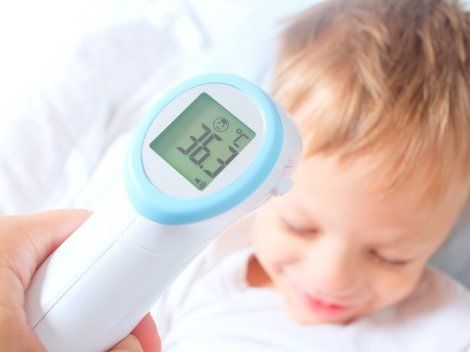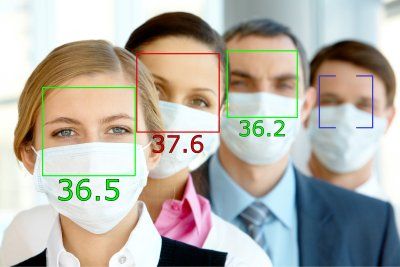Human Body Temperature Measurements
One of the main applications of single thermopile sensors is non-contact human body temperature measurement. An elevated body temperature or fever is related to many diseases and can be a first indicator, whether a person is healthy or not. If you want to know.
if a person has an elevated temperature, you first have to know what his normal temperature is. Therefore, it is important to know,
that there is a relatively wide range of core body temperatures which are considered "healthy", from 36.1°C to 37.2°C. Each individual has its own "normal" temperature which also varies throughout the day. A core body temperature of above 38°C is in general considered as fever.
There are different methods of measuring the body temperature and most of them do not measure the core temperature of the body.
They measure a value which is related to the core body temperature and can be used to determine the core body temperature.
Common methods include rectal, oral and axillary temperature measurements. They are performed with standard thermometers. Rectal is most accurate and reliable to determine the core temperature. Oral and axillary are also good methods which are more convenient. Taking body temperature with a normal thermometer takes up to 30 to 60 seconds. This is an acceptable length of time for private usage, but in the medical environment, time is precious and rapid infrared thermometers are the tools of choice.
Infrared Thermometer Basics
Infrared thermometers provide very fast measurements (1-2 seconds) and consequently are more convenient than conventional thermometers. Nonetheless, it is only possible to measure the surface temperature of the skin, which is not the same as the core
body temperature. Skin temperature is a mixture of core body temperature and ambient temperature and therefore changes not only
due to fever, but also due to changes in the ambient temperature. It is therefore important to measure in a location on the body,
which reliably gives a core body temperature related value.
For clinical application, the measurement range should be from 35.5°C to 42.0°C at least with an accuracy of ±0.2°C or better. Regarding the infrared emission of the skin at this temperature, peak emission wavelength is of approx. 9.4 µm to 9.2 µm,
which is in the far IR range. Thermopiles optimized for highest detectivity in this exact range are the best choice for this application.
In-Ear Temperature Measurements
In-ear thermometers are equipped with a single thermopile sensor at the tip. There are different sizes of thermometers customized for adults, babies and pets. In general, a baby ear thermometer needs a smaller sensor at the tip as the auditory canal is smaller. A smaller sensor on the other hand means in general less signal and requires more sophisticated readout electronics.
The temperature inside the auditory canal is at some distance from the ambient air. Thus, it is more stable than the skin of the forehead, exposed to ambient effects. Studies have shown that there is a direct relationship between in-ear temperature and core body temperature. That is why the core body temperature can be calculated from the sensed in-ear temperature. This makes the in-ear thermometer the most reliable IR thermometer compared to forehead thermometers or mass fever screening devices.
Advantages of ear thermometers are:
- Almost no influence of the atmosphere and ambient temperature as the sensor is placed close to the skin
- Fast measurements less than 1 second
- Most reliable IR measurements if applied correctly
Disadvantages of ear thermometers are:
- Measurement is sensitive to sampling of correct spot inside the auditory channel, which requires experience
- A little less convenient than forehead thermometer measurements
- Sensor has to be clean to get all radiation and therefore a correct temperature value
Recommended sensors:
- HMS-Series (K1c1, J11 and Z11)
- HTS-Series
Forehead Temperature Measurements
Most forehead thermometers are based on the same working principle as the in-ear counterparts. They measure the surface temperature of the skin. But as this is much more influenced by ambient temperature, that the in-ear temperature, you need to measure at the spot, where the temporal vessels are directly behind the skin. As the blood comes directly from the heart which is at core body temperature, this gives the best measurement results.
Owing to the fact that you cannot see the temporal vessels, most forehead thermometers are scanned by hand, sweeping over the forehead to cover a wider region including the temporal vessels. While the hand scan proceeds, the instrument records several hundreds or thousands of data points and picks the hottest spot, corresponding to temporal vessel location, to calculate the core body temperature. This can be done with a single thermopile sensor like those used for ear thermometers, if the measurement is very close to the patient's skin.
If you must stay away from the forehead to avoid transmission of infections, simple single sensors can be equipped with lens optics
to allow non-contact measurement at short distance. Without a lens to image the target onto the sensitive chip, the measured area increases with distance until the signal from the temporal vessel is lost in signal from surrounding area.
Another option is to use thermopile array sensors with small resolutions like 8x8 or 16x16. They can scan the whole forehead
all at once and allow measurements in distances of 30cm to 1m and more. They can also sense and locate the hottest spot for core body temperature calculation. In this case it is important that the individual pixels "see" as small as possible areas to get best accuracy results. Thus they need an optic with rather small field of view. For measurements from distances of up to 1m, the absorption
of the atmosphere will already have significant impact which should be considered to get accurate measurement results.
Advantages of forehead themometers are:
- Very comfortable since nothing has to be inserted
- Fast measurements in just a few seconds
- Very small risk of transmission of infections
Disadvantages of forehead thermometers are:
- Measurement accuracy is sensitive to choosing the correct measurement position on the forehead
- Compensation for ambient temperature changes is required
- Higher cost
Recommended sensors:
Elevated Body Temperature Screening and Fever Screening
Starting in 2003 with the spread of SARS, Singapore was one of the first countries to use fever screening systems with thermal cameras to control the spread of the disease. Since then, every time a new virus has come into circulation, this topic re-emerged, including in 2009 with the swine flu pandemic which is estimated to have infected about 1 billion people around the globe. Now, with the spread of the new coronavirus and COVID-19, fever screening systems, became of great interest again.
Such systems can be installed in public places where people pass
and/or come together. This is the case for airports, office buildings
and schools, public transportation like bus and subway. And also at theaters, cinemas and fair grounds elevated body temperature screening can be helpful as safety precaution.
Fever screening systems are designed to detect the temperature of people walking through a security gate or checkpoint,
e.g. at the arrival at an airport. To measure people's temperature, the system is equipped with a thermal sensor with spatial resolution.
A thermopile array with 32x32 or 80x64 pixels is sufficient. The screening system identifies the forehead and measures its maximum temperature. With an internal threshold, it can immediately decide if the person should be suspected of having a fever. If so, the person should be rechecked with common forehead thermometers for better accuracy.
Since "normal" body temperature varies from person to person, the threshold value is an important parameter. If the value is too low, many people are suspected to be febrile even if they are not. If the value is too high, persons with fever might not be detected.
To control the spread of a virus in times of pandemics, it is probably a good idea to choose a lower threshold and put some effort
into manual rechecking. In normal times it is also sufficient to detect only high fever and therefore to choose a higher threshold value.
Besides actual fever screening, there is another method called elevated body temperature screening. In this case the temperature
of a person is compared to the last 10 or 20 passengers. If the temperature is higher than the average temperature, then the person
is suspected to have an elevated body temperature and should be re-checked with a medical thermometer. This method helps
to reduce the influence of ambient conditions on the non-contact body temperature measurement and can help to achieve more
reliable fever detection.
In any case, one should make sure that the system is operated properly, e.g. by sticking to the guidelines provided by the American FDA.
Advantages of elevated body temperature screening or fever screening:
- Fast measurements of many people to avoid long lines and delays
- No contact with measurement system and therefore no transmission of infections
Disadvantages of elevated body temperature screening or fever screening:
- In most cases less accurate that ear thermometer or forehead thermometer
- Possibility of false positive or false negative detection
- Requirement for secondary screening of suspected positives for improved accuracy
Recommended sensors:




